Get Free Guides To Ascension & Global Consciousness

We met the Zen 2.0 founders at Wisdom 2.0 last year where we were a media partner again (we love this conference — see our coverage from 2018 and 2019 as well as last year’s video), so was thrilled to hear about their consciousness-focused conference in Japan later in September. And so, we teamed up with Zen 2.0 as a media partner this year because we were curious what they were up to and what they would choose to focus on to bridge the older generations with this one. In other words, how would it differ than the kinds of things we focus on in the west and where would it be similar?
Their hope was to create a “soul connection” for what many might call call an “awakening” and given the topics they covered, I think they succeeded at giving people a great taste of what it means to lead a life fully awake. A key thing that made this event different from any spiritual event Kencho-jiI’ve attended in the west is that it was held at Kencho-ji, which is a Buddhist temple in Kamakura, a town roughly an hour south of Tokyo by train along the coast.

For three days this fall, we dove head first into all the unique and special talks, workshops and interactive sessions that they had to offer on-site at Kencho-ji. Zen 2.0 values compassion so highly that they list it as their first bullet for what they wish attendees to feel at the conference. In the middle of it all, it’s about meeting like-minded people who are on a journey to awaken the magic within while having fun in the process. This Mindful City of Kamakura is surrounded by nature and faces the water, which is nurturing and healing in itself. 

Zen 2.0 is now in its third year and continue to focus on one of their prime goals: to offer a forum and physical place where different people who share different forms of wisdom to gather and share ideas. They want to ultimately connect the past and the future and for us to realize that they are already interconnected.
In other words, if we can actually realize that we are all interconnected, then the landscape for the world changes. Our view of that landscape changes. Our view of ourselves changes.
And, most certainly our view of others and how we interact, work, play and love all changes, dramatically. This leads to transformation on multiple levels and in this transformative place, you ascend and transcend simultaneously.
Their hope is that Zen 2.0 will create bonds, which cannot be done in an online forum the way it can on the physical plain, where we can engage one-on-one and learn about each other’s differences and where our beliefs overlap. In this way, relationships and experiences themselves can transcend the divisions of faith, sect, region, country or culture. Their vision is right up our alley.
I invite you to go no a journey with us to experience what we did in late September, which is the first time we have attended an event of this nature in Asia, opposed to a retreat, workshop or yoga-type of gathering, which is so prevalent in the East, but doesn’t often attract a mainstream audience. Zen 2.0 attracted the “curious” as well as those already on a path of higher consciousness and spiritual living.

We learned that they have a different theme every year and this year’s theme was all about Connectedness. As we enter what they refer to as the Reiwa Era, we are still dealing with the endless deluge of (mis)information from social media, which is adding to the stresses of our daily lifestyles and jobs. But it’s not just technology and digital media, is it?
So many more issues are facing us on a daily basis that didn’t exist a generation ago. But technology is indeed a big part of it. While it has opened up so many opportunities we wouldn’t have had without it, when it’s not in balance, we end up sinking downstream, rather than swimming in perfect flow upstream to a higher place of consciousness.

They provided both hands-on events and workshops so that the connections made aren’t simply names on business cards, but “connections of and from the soul” so we can all support one another. Kindness, compassion and support are an integral part of it.

Upstairs, there were a few different breakout rooms for more experiential sessions and other rooms for quieter ones, i.e., meditation and so on. Downstairs in the main Kencho-ji temple was where they held the keynote speakers and top talks.

Kencho-ji, the head temple of the Kencho-ji branch of the Rinzai School of Zen. All three Zen 2.0 events have now been held at this historic venue that is over 760 years old. We could really feel the profound and sublime energy as we walked through the holy grounds of Kencho-ji.

Downstairs in the main part of the temple, they had main speakers addressing a much larger group. Translation into English was done by a few translators often in the far upper left or far upper right of the room. Below is a session in the main room of the temple and the woman with the glasses was our translator.

There’s beauty in the dragon and it is so symbolic and such an integral part of the Japanese culture and history.
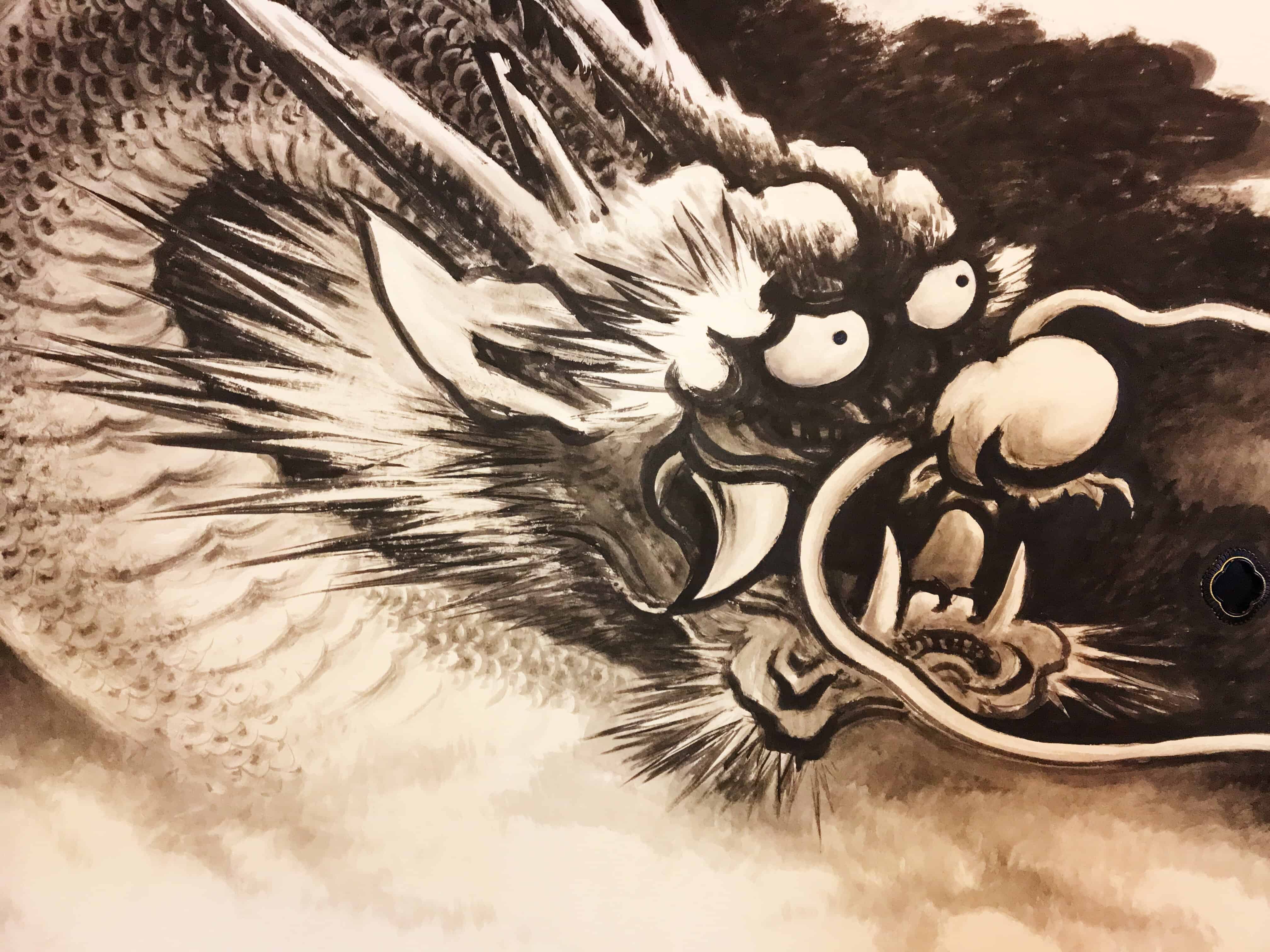
Toji Kamata and Hiroaki Kumano (who we got a lift from the hotel to the venue one morning), held a session in the main room on the Wisdom and Mindfulness of Japan. Of course, a large part of this presentation was centered around Shintoism, which is no surprise.

Kamata who is a philosopher, religious scholar and professor of Grief Care Institute and Sophia University, is dynamic on stage (in a quiet way) and has a sense of humor as he talks about some of his own at-home practices, which oddly enough includes going to the bathroom in the dark. The idea is that all of your other senses become more acutely aware of being present in what you’re doing, including functional bodily things. And, Humano’s perspective comes from his research work as a Waseda University professor on applying mindfulness and acceptance to Cognitive & Behavioral Therapy.

Interestingly enough, I noticed that Kamata was dressed all in green, including his pants. His response was that he loves green as its connected to nature and Earth energy. It is no surprise that he is so drawn to Shintoism and not just because he’s Japanese but because there’s something in his Innate and Soul that is driven to teach it at a global level. Says Kamata, “A Japanese farmer should be able to hear the tomato speak.” He shared both data and ancient wisdom with us, including the latest from a Sofia University academic who was able to talk to trees and other aspects of nature.
“Talking to nature is equivalent to allowing life to take you in perfect flow.” — Toji Kamata
Says Kamata, “communicating and listening to nature allows nature to lead you.” This is related of course to your emerging intuition. Our translator Kaori at this time shared two words with me: Ginsay and Inochi, which means Life Force. As she was struggling to translate the ‘right words’ in English, she looked at me and said, there really isn’t the exact words to explain what he is saying here. I understood this of course because you often can’t do an exact translation from one language to another and have it be “exactly” as the person had intended it. There are often so many nuances when you talk about complex and deep topics such as the nature of the heart and spirituality.
Intuitively, I said to her, “does he mean that essentially the entire Universe speaks and can speak to us and we have the ability to speak to it in a way that will listen and respond?” She started nodding profusely because I guess I had nailed it. Isn’t it ironic that I used my intuition to get to the jist of what he was really saying — I could actually FEEL what he was trying to say through his body and his intention. Kamata says he is very tuned into his body and even at his age now, he does back flips as a way to give a ‘present nod’ if you will to both the heavens and the Earth. Going to the bathroom in the dark is an example of truly tuning in with his body. In darkness, he asserts, “the boundaries between you (assume he means your soul) and your body become blurred, a kinda returning to the womb experience. In this darkness, it makes you wonder how your body is connected to everything. It’s a way of listening to what your body is telling you.”
“In darkness, it makes you wonder how your body is connected to everything and….a way of listening to what your body is telling you.”
He also spoke of how power spots in the world are increasingly becoming popular destinations for people, eager to feel the energy from sacred land. Here, he’s referring to places like Peru, Israel, India, China, Japan and other ancient civilizations. Kamata referred to a massive cave and forest in Japan that is sacred and how over time, the Japanese have learned how to survive and be connected and in flow with the Universe, because they’ve had to with so many natural disasters and other hiccups in history. Did you know that Japan is the only country in the world where four titonic plates lie on top of each other? I did not before his talk.
Interestingly enough, Kamakura, which is where the Zen 2.0 is held, is a bit like a curved urn, our translator says. Kura means storage and it relates to where spirits gather. Everything is connected and it’s no surprise that this event is being held in a place like Kamakura. He asserts that when you begin to have awareness about everything, then you’ll start to have more questions which moves you forward. So, he asks the audience: can we leave where we are? Can we move forward and if and when we do, what comes first, Ego or Awareness? This question won’t really get you anywhere since they are parallel questions in a way. Letting go in order to move forward is really Surrender. I really loved this man’s energy and hope we have an opportunity to connect in person again — his insights are simple and yet profound, which is the art of a real master.
We were fortunate to meet Kathleen Reiley, an American nun who has been living in Japan for decades. Some continuously brought a smile to my face every time I ran into her, whether it was at the temple itself or during the after party and activities with speakers and sponsors only. I was so surprised to see a Catholic sister at this event….a Catholic Maryknoll sister to be exact. She talks a lot about compassion and empathy, understanding what it means to understand and resonate with (and feel) other people’s pains. No surprise that she has learned a lot about the topic as she spends her time counseling children with cancer and their families.
Hailing from Pennsylvania originally, Sister Kathleen was asked to join the Catholic Tokyo Volunteers, whose main responsibility is ministering to the people of Fukushima in Japan. They had to evacuate after the March 2011 Tsunami destroyed the nuclear power plant there, spewing radiation into the environment. She was also involved in a hostel for abandoned children and worked in ministry with alcoholics and day laborers. Her career began leading retreats at Zen Christian Zendo in Tokyo and in Munich, Germany, an activity she still continues today. She asserts that when you’re in silence, you can truly ‘listen’, understand and connect.
Together with Genki Shiota, co-founder of Wisdom 2.0 Japan (yup, it’s coming to Japan) Junya Ogino led a session called “Journey of the Soul“. By day, Junya is the CEO of the Mindful Leadership Institute and Genki is co-founder of a mobile gaming and live experience company who has a vision of making the world a “Heart-Driven World.”
In the Journey of the Soul session, they spoke about connecting to yourself FIRST. As a group, they asked us to sway back and forth so we could sense where our center was….in other words, KNOW THY CENTER!
“Your Center is the Center of Your Gravity!”
In this place, you can sit really still. They had us put our left hand over our right and then put our hand where our leg starts while closing our eyes as a way to get grounded. We then took 3-4 deep breaths as a way to arrive back to the “here and now” completely and fully.  The speakers asked: “while you breathe, experience these questions in a present state of mind: why did you choose to be here in this session?”
The speakers asked: “while you breathe, experience these questions in a present state of mind: why did you choose to be here in this session?”
And from this place, it’s yours to fully experience whatever comes up. Genki added, “what’s the real reason you came to this session?” I smiled. “Don’t think what it is, something will come up and whatever it is, just experience that.”
Then, once again, they added: “in your life, you invested 45 minutes to an hour to this session — honor whatever images and feelings come up when you think about this and notice your breathing as you do.”
In this awareness, do you experience being fully here now and feeling fully grounded? They kept trying to get attendees back to awareness, being aware of that awareness and then to a feeling and sense of connected-ness, both to yourself (the grounding) but also to others. After feeling grounded yourself, next of course, is feeling grounded to others. The key is not to dictate what comes up, nor judge it — just let whatever it IS, flow through you and be aware of all the things which come up as you go through this process — negative, positive and neutral.
They were really trying to get people to FEEL into whatever is – no right, no wrong, but simply honoring what is and when we can truly do this, we are honoring our Soul and quite frankly, living from a place where our Soul drives our decisions, not our minds, which is ultimately the most powerful place to be.
Because many sessions were happening simultaneously (main room and break-out rooms which included experiential activities), I wasn’t able to see them all. I was drawn to go to a session that was led by a duo on Mindfulness Connecting to Home, as “home” means so many things to different people. Our Soul is also home, is it not?
Kumiko Jin (a history teacher in the Tokyo area) and Keisuke Shimada led this session. Shimada’s background is as a book translator but also a writer, mindfulness meditation facilitator, Psychiatric Social Worker and also a Plum Village member (we are huge fans). For those not familiar with Plum Village, it is a Buddhist monastery of the Plum Village Tradition in the Dordogne, southern France which was founded by Vietnamese monastics, Thích Nhất Hạnh and Chân Không back in 1982.
Rather than define what home is, it is left to the individual whose Soul will define it (and feel and experience it) differently. Once again, it’s all about honoring what comes up and connecting to it in a divine way, without judgment, without edits.
I was so excited to sit in on a Tea Ceremony (and workshop). The latter is an important aspect as tea master Kyoko “Myokyo” Denda taught us why different gestures and steps are done in the way they are done. Known nationally as a Mushakouji-senke tea master, she explained how one partakes matcha tea in a way to understand the essence of nature and being present, in order to awaken one’s consciousness to higher levels.

We learn that there’s a certain placement of the bowl, the whisk and the wooden spoon and they all have a purpose of being in a particular place at any given time. There’s a flow when it comes to making matcha tea in a mindful way. As an avid tea drinker, I would mesmerized by her motions and how particular she was every step of the way. For example, the ceramic holder that contains the tea sits at 9 pm and the whisk is at 12 pm, whereas the bowl is right in the center. Your napkin goes at 3 pm and the wooden spoon is at 4:3o pm.

Notice how upright she is sitting when she whisks — it’s important that your back is straight and you are facing the bowl straight on, not at an angle. She says, “be aware of the axis of how you sit. The space before you is like a stage you are creating. Step one is cleaning the tea (you use a thermos of hot water for this process). Step two is whisking — my translator tells me that it is the left hand which takes the whisk. (Note that I was the only non-Japanese attendee at the workshop). The whisking process is an art — it’s important that the bubbles and froth are ‘just right.’

After we cleaned our tea btw, we all bowed down to our bowl and utensils. Notice this process alone is teaching you the art of being present, the art of gratitude and the art of realizing that everything is interconnected in life, including the tea that you create and the drink.

In the process, she teaches us, you’ll learn that there is intention behind everything, a bit like how life ‘should be.’ So often, we are running around like hampsters in a wheel and not being intentional about what we want in our lives and how we wish to live. Intention even goes into how perfectly paired the desserts are that you choose to eat with your tea. Note how that I purposely added the word “choose.” So often, we don’t choose things in our lives, we react to it.
She says, notice the colors — in this particular ceremony, there were many greens and browns in the sweets and this is because we are honoring the Autumn season. Tea in one region however will be different than another region as will the sweets and what is chosen will always depend on the season.

Also purposeful is the tea cup that you select, which is done at the beginning of the process as well. She also carefully cleaned each tea cup before we got started. Even how you hold the tea cup and the whisk seemed to matter. For example, she would put her left hand under the bottom and the right hand would carefully go around the cup for support. The bowls are also chosen by season. With every selection, there is an intention.

Even though we were learning on a wooden table, she says that there are even more intricate details when you learn more formerly. While it likely makes logical sense that you would choose certain tea cups, type of tea and desserts, you might not think about the type of mat for example. She usually makes and has tea on a mat and it is usually in a much smaller room than the large room where we learned. The entrance is often very low to enter the room — the idea behind this is to humble (and lower) yourself, so that you‘re reminded to be humble and get your ego out of the way.

“Paying attention to every aspect & element of nature, slowly we purposely open ourselves up to a higher consciousness.”
Later in the Zen 2.0 Conference, we had an opportunity to experience a tea ceremony with Denda in a more traditional setting and did indeed have to bow down to enter the small room.

She says, “we pay attention to every aspect and element of nature, slowly and with intent, and when we do so and are aware of this, even for something as simple as drinking tea, we are purposely opening ourselves up to a higher consciousness.”

In this way, we can also become more connected….to ourselves and to others. Be sure to read our write-up on Higher Consciousness Through the Japanese Tea, which expands on this ‘art’ a bit more.
What a wonderful chat we had with Issho Fujita who is a SotoZen priest, former director of Soto Zen Buddhism International Center and former head teacher of Pioneer Valley’s Zendo in the United States. Be sure to read our standalone article which includes a video interview on this remarkable Buddhist teacher. He led a standalone session in the main room as part of the opening ceremony entitled: “Zazen: Practice to Deepen Connectedness.”

He talked to us about his journey, which is a remarkable one. We’ve all had our own trials and tribulations and he has had his own. We somehow think that Buddhist monks have “zen” together at birth and we don’t realize that they too had their own journey. The art of sitting still, the art of mindfulness, the art of gratitude and just ‘being’, the art of deepened connectedness, is all something that he learned along the way. And then later on, taught, in the United States as well as in Japan where he now lives.


We LOVED his energy, so be sure to read more here. I wished we had a chance to hang out (and learn from him) for a few days, not hours.

Japanese dancer Masako Ono is the only Japanese Odissi dancer empaneled by the Government of India and Culture Department. She asserts that we can connect to the Universe within us all as well as to the outside Universe through dance. She led a “Saraswati–Yoga“ workshop teaching us all to go into poses (what they mean) and how to hold them, all to be more present and get connected with ourselves and a Higher Consciousness.

Her moves were fascinating and it seemed as if everything she did had intention and purpose — slowly and in consciousness. Her dance aspects and movement are largely influenced by Hinduism but there are universal aspects of dance in them as well as yoga. She talked a lot about yoga and the chakra system in her talk, how the chakras spiral upward from the root/base chakra.
She says, “there’s a negative and positive energy that goes up through the body to balance each other, similar to a DNA spiral. As you progress in this practice, you begin to feel it throughout your body, all the way up to your crown chakra.”
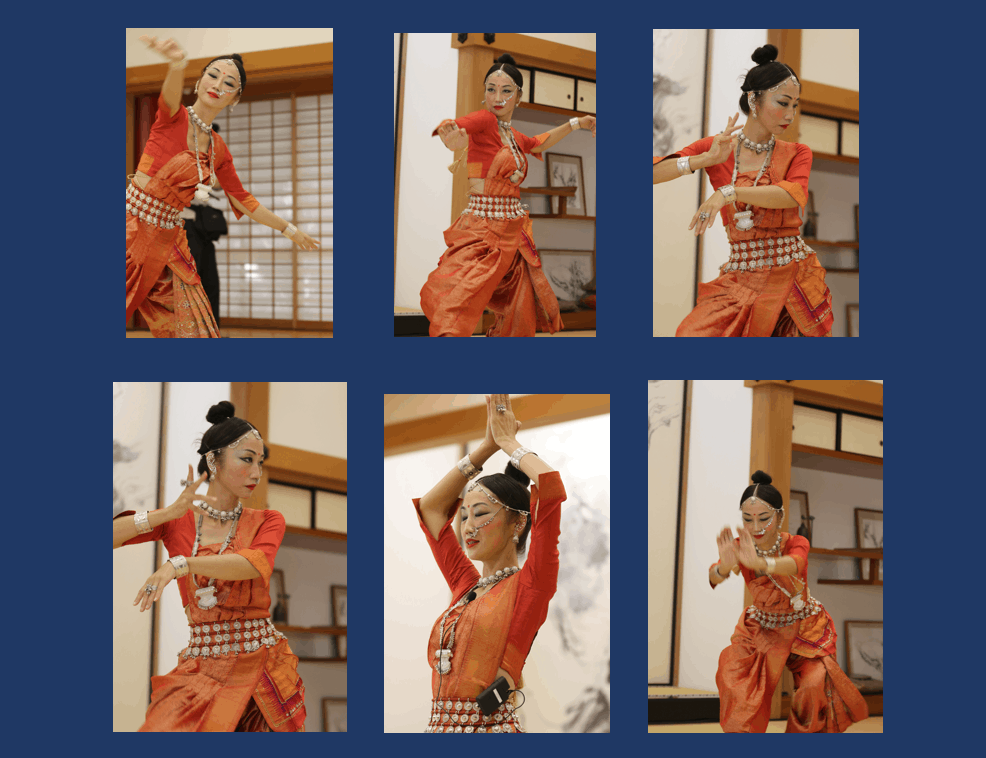
Masako Ono asserts that this dance connects you to the natural world outside yourself. The magic of yoga and dance can take you there which is often easier than words or the mind. She learned this dance in the Eastern part of India in a region called Orissa, which is now called Odisha, where she currently has a base. Based in the Bay of Bengal, is known for its tribal cultures and its many ancient Hindu temples. The capital, Bhubaneswar, is home to hundreds of temples, notably the intricately-carved Mukteshvara. In other words, it’s a very spiritually charged place, however it has also had a lot of battles historically.
It doesn’t often show up in guidebooks, but there was much that she learned her about dance, about this practice and about Buddhism in general (there are many Buddhist monuments here as well). She speaks of three main positions and angles. After she did a beautiful performance for us, she launched into workshop and teaching mode.

There’s a specific angle that the body takes, the knees and the arms. She says to the attendees: “drop your body so your bottom chakra is low, so you feel pulled down into the Earth. Then, feel your head being pulled up beyond your body, above the Earth.” Here, it seems she’s trying to get people to feel both the power of being grounded while also connecting to Higher Realms.
Says Ono, “as you look out and observe, think of and imagine what you love deeply — infinite love is good, but for others, it may be other things that are not on someone else’s radar, like your cat, your child or nature itself.”

As you concentrate on these things that you love, she says to be present with it as you are looking out into space, fixated on what you love. This fixation on divine love and gratitude helps keep you steady when you are trying to hold a steady position for a long period of time. As many of us discovered from trying these moves (and moreso trying to hold them), it was difficult if you’re not used to it. All of us tried moving our torsos, while also moving our neck and eyes back and forth slowly, but steadily. You do not move your neck, but you do end up using your abdominal muscles quite a bit.
The key here is to get the feeling of being extended and suspended from the top to above your crown chakra. She says in this way, you are not only present but connected to a Higher Consciousness beyond your body. The performance and workshop were both powerful and I could see this practice as a way to connect to Higher Realms and Dimensions. It’s her art and her power — whatever it takes to get you there is what you should practice. It will be different for everyone.
Mindful eating is a topic that we are seeing more and more in the west. After all, it’s no secret that we have both an obesity and diabetes problem in the United States, an issue which is starting to spread to other parts of the sugar. Sugar and processed food consumption is at an all time high although awareness about the importance of what we eat is increasing. I’m sure you’ve heard the saying: Garbage in, Garbage out.
Mindful eating however extends far beyond what you eat, but relates to how we think about what we eat, the presence we have when we eat and awareness about both what we eat and the feelings that emerge as we eat. Eating slower is super helpful in getting us to this place but it’s only part of the equation.
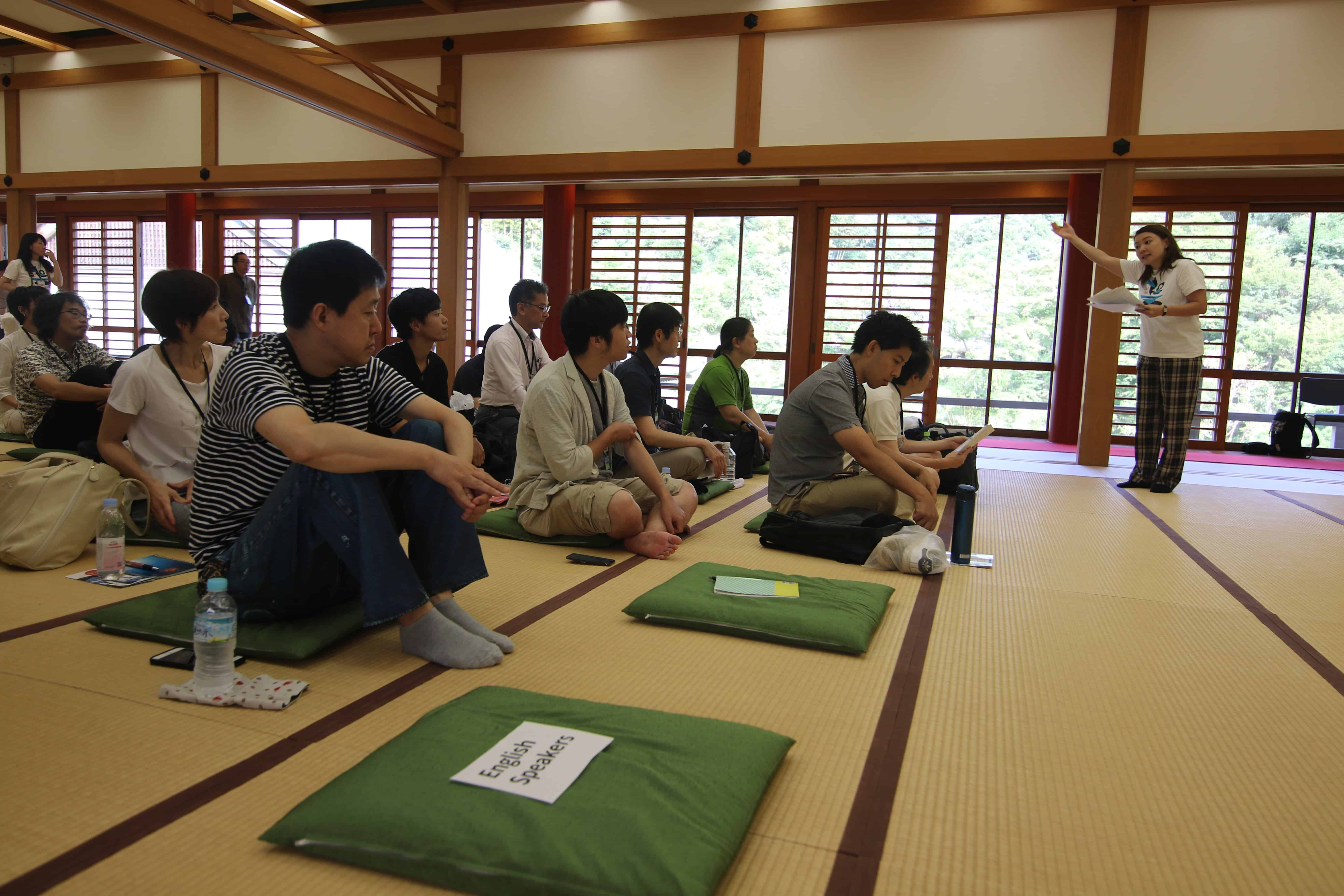
Quite frankly, I was surprised to see a session on Mindful Eating which Miki Kanamaru led with Buddhist monk Kakuho Aoe. Why? Because it seems to me that the Japanese people are mindful about their eating on a regular basis and that it is so integrated into their culture and way of being that it hardly seems like a problem. Rather than a heavy ham and cheese sandwich with potato chips and a cookie which is typically served at western conferences, they served Binto boxes here, which were small but tasty and had plenty of veggies. And, I also noticed that people take their time when they eat and at least in the circles we frequented during our Japan stay, were mindful about how they ate and chose to eat.


Because we were in Japan, the principles of Mindful Eating went even further. Kakuho Aoe asked us five questions about eating from a Buddhist perspective. He spoke about the prayer or meditation they did before they eat and how we can incorporate that into our every day lives. It was common in our grandparents era, he asserts, to say something before we partook in food. In the west, this was true too. We typically said grace as a way to bless our food and the people at the table. Rarely is that done anymore.
“This Food Will BECOME You!”
Aoe says, “it is a way to honor the food we eat and to think about everything and everyone involved in the process from start to end, i.e., the animals, farmers, the distributors, the stores. He emphasized the importance of thinking about the food from a place of grace, not from a place of greed. In other words: this food will BE you. BECOME you. I find that this is very Pagan as well as Shinto, both of which are based on Earth-based belief systems. In other words, Honor Gaia as she is part of you and she will honor you back.
He tells us how they chant a mantra before they eat. We were then given a few pieces of chocolate to eat. “We will all eat this chocolate but each of us will feel differently about a question that you bring up to ponder and contemplate as you eat. You will feel different about the same question each day because each day is different and this is true about food too.” He then gave us five questions to ask ourselves and to note which one resonates the most for us. The five questions and/or statements to consider are:
The questions are odd when you think about them, however it’s not so much about the questions and statements here, but more what resonates and how you feel about them. What comes up to the surface as you say these things out loud? Food is a path you go through with Buddhism so in a way, to be the Buddha, you eat food. The translation may not be quite right, but in essence: in this workshop, you’re not really a Buddha — how do you live and march forward on your path? How do you learn how to be the Buddha him/itself?

The consideration here is how to be mindful about food itself, so you understand how we are all connected when we partake in meals. As we eat, we need to be aware that we are taking a creature’s life to eat this food (in the case of meat of course). Does your eating come from a place of greed? (I can eat whatever I wish without consideration to others) or if I truly know that the food will BECOME me tomorrow, then can I learn to approach my eating with a healthy and balanced perspective, one with incorporates gratitude and thanks?

Above Kukuho Aoe and I — Anthony and I loved chatting with him. Aoe is the master monk of the Ryokusenji Temple at Asakusa, which we visited on our first day in Tokyo. He’s also a chef of the temple cuisine and has published many books and magazines.
The grounds at the Zen Kenchji Temple are stunning. They have a beautiful energy and spiritual essence, as if a beautiful vortex is surrounding you as you walk. Have a look at some of the magical buildings, trees, flowers and beyond. We found it hard to leave.











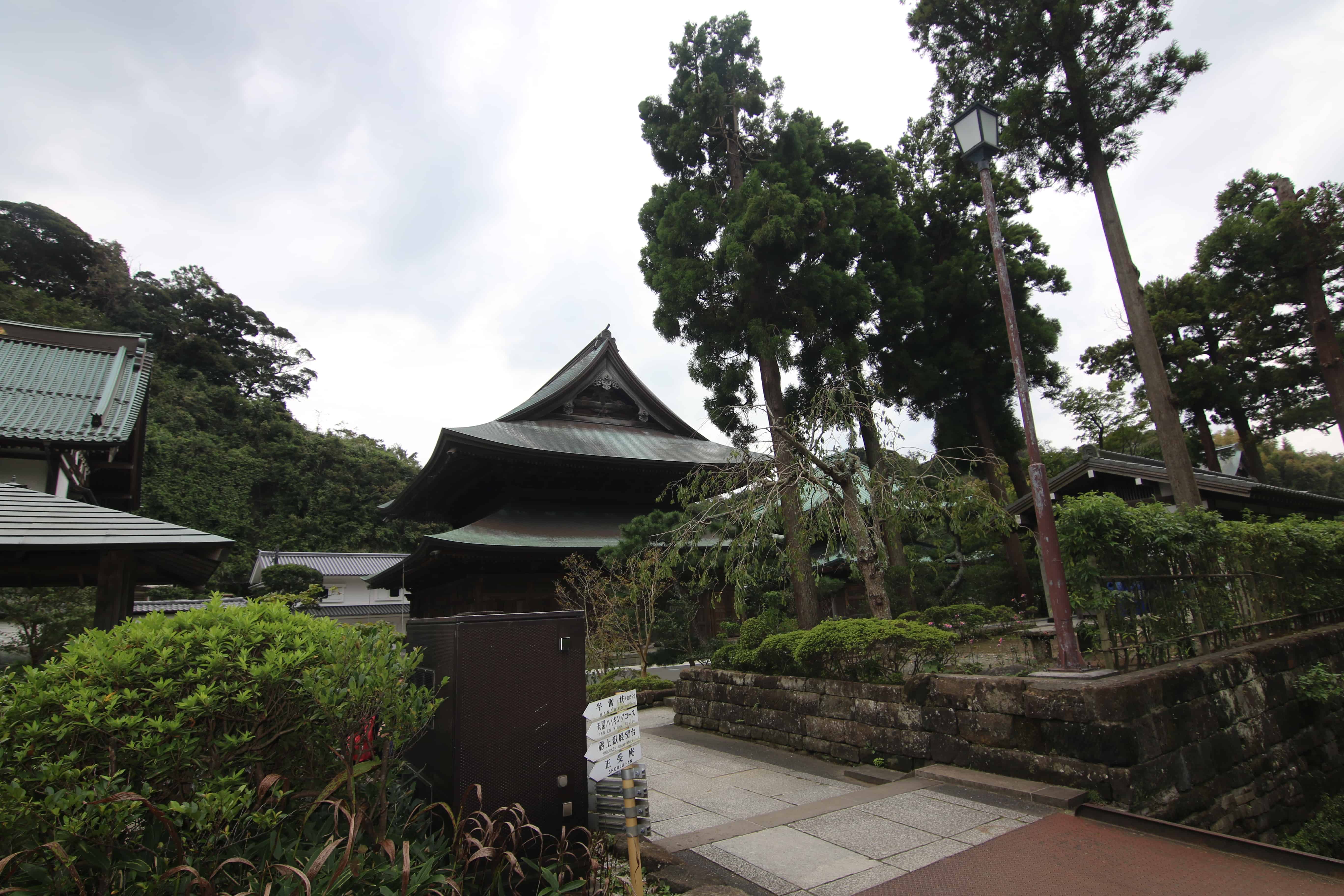





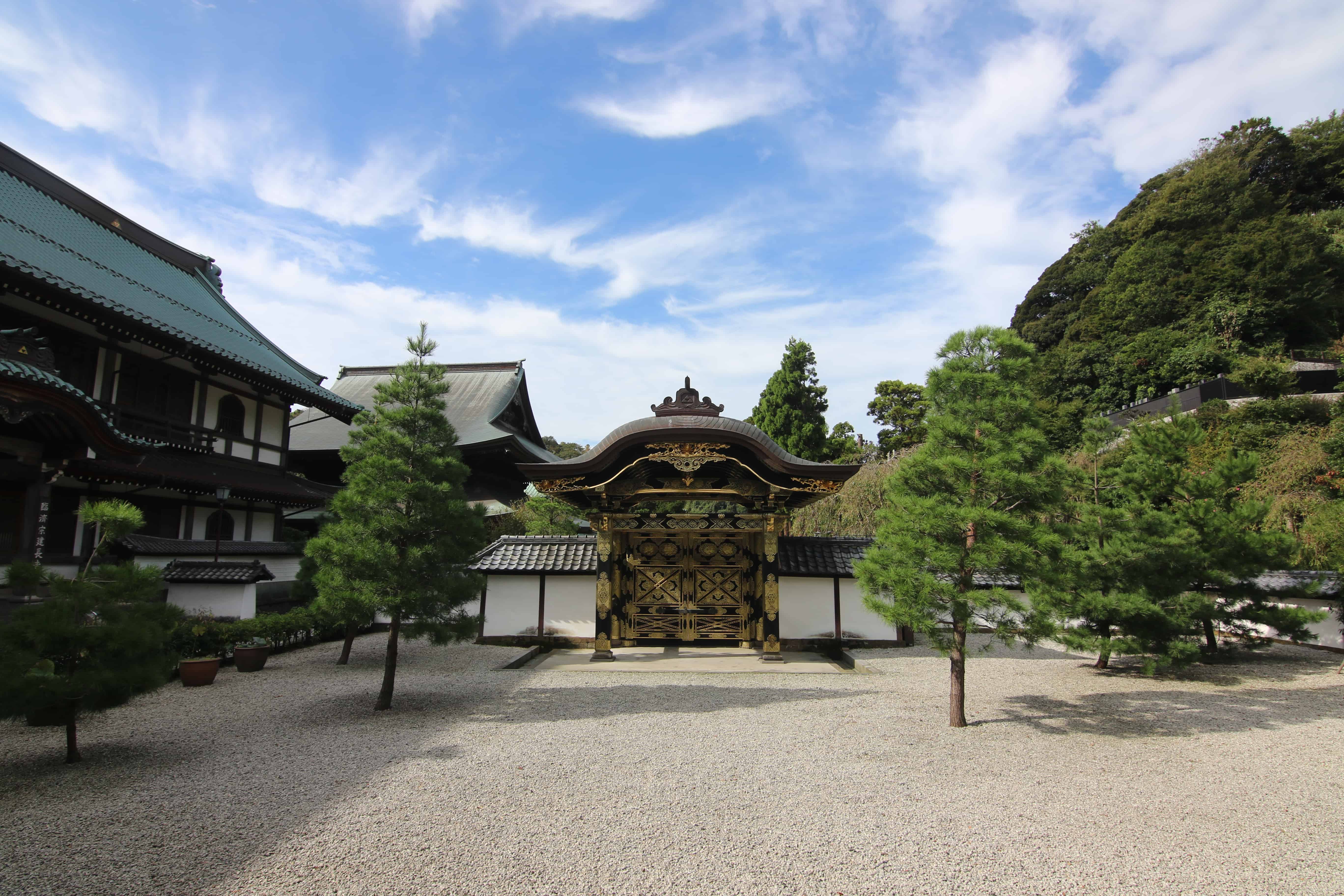

There were some break-out sessions we missed, but quite frankly, I was interested in them all if we had more time and bandwidth. We also loved just how interactive so many of the offered sessions were.

Behind the scenes at Zen 2.0 were dozens of volunteers who helped make this year’s event happen.







The visionaries and founders of Zen 2.0 are Kouji Miki and Mikio Shishido. Below, they do a recap and end-of-day “pow-wow“ with the volunteers in the large room where we had lunch.
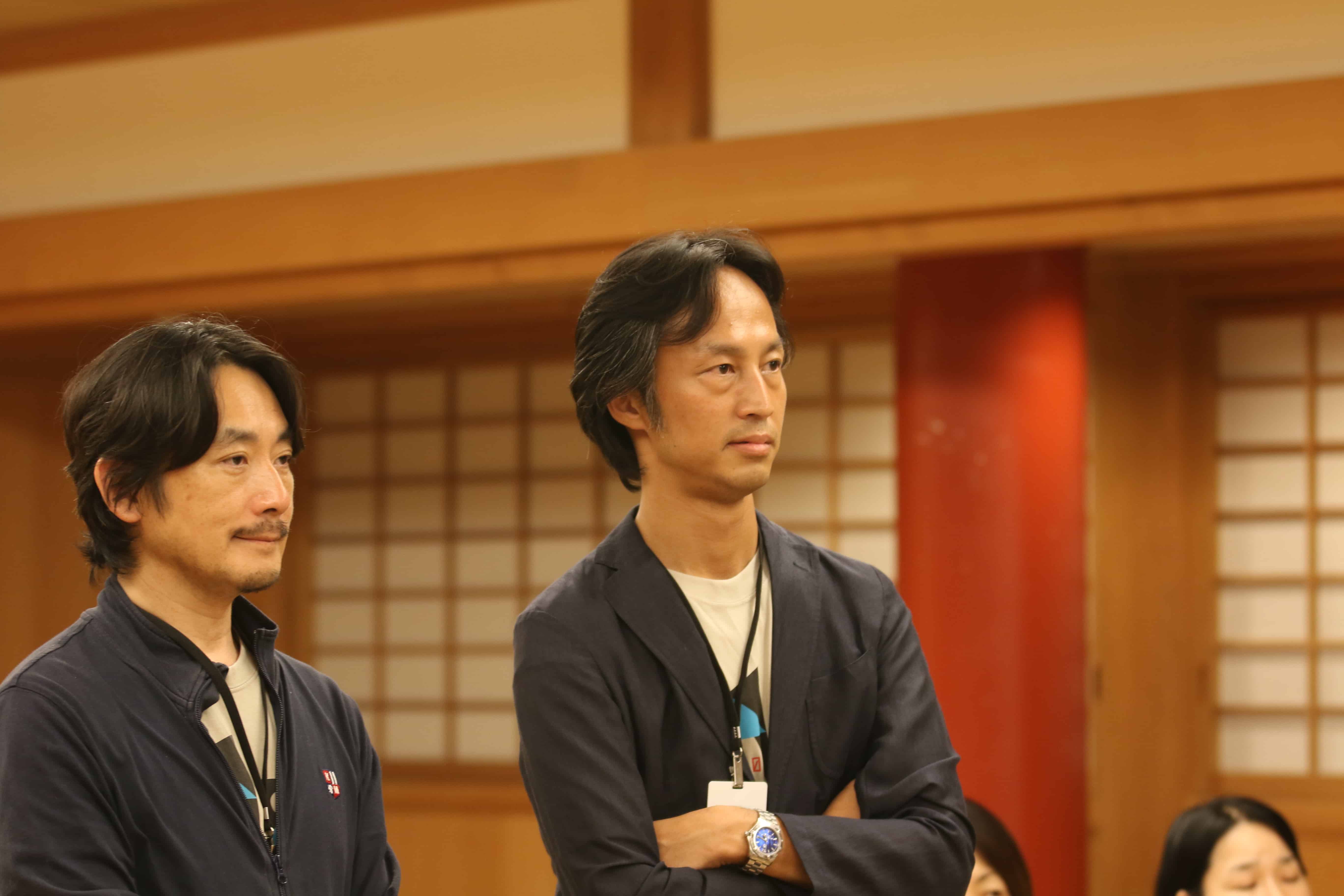


We loved the speaker reception, where we got an opportunity to meet some of the visionaries behind all the ideas presented at Zen 2.0 this year.


And, the food was amaaaaazing!





We also had a chance to speak to Zen 2.0 speaker Stephen Murphy-Shigematsu who speaks fluent English because he teaches Mindfulness in the Classroom at Stanford University in northern California. We loved his energy and hope to learn more about his work on home turf.

Below, we participated in a fascinating discussion with the speakers after the event closed. We learned about their insights and take-aways from other speakers and sessions as well as shared their own wisdom. We don’t really do that in the states and I love the idea. What it did was make us all feel more interconnected to each other, which of course was the main theme of this year’s Zen 2.0 event. Everyone also had an opportunity to tell others about their worlds and perspectives, which made it a seamless way to cross pollinate ideas and figure out the best places to collaborate. Luckily we were sitting next to Stephen Murphy-Shigematsu who translated the session for us.
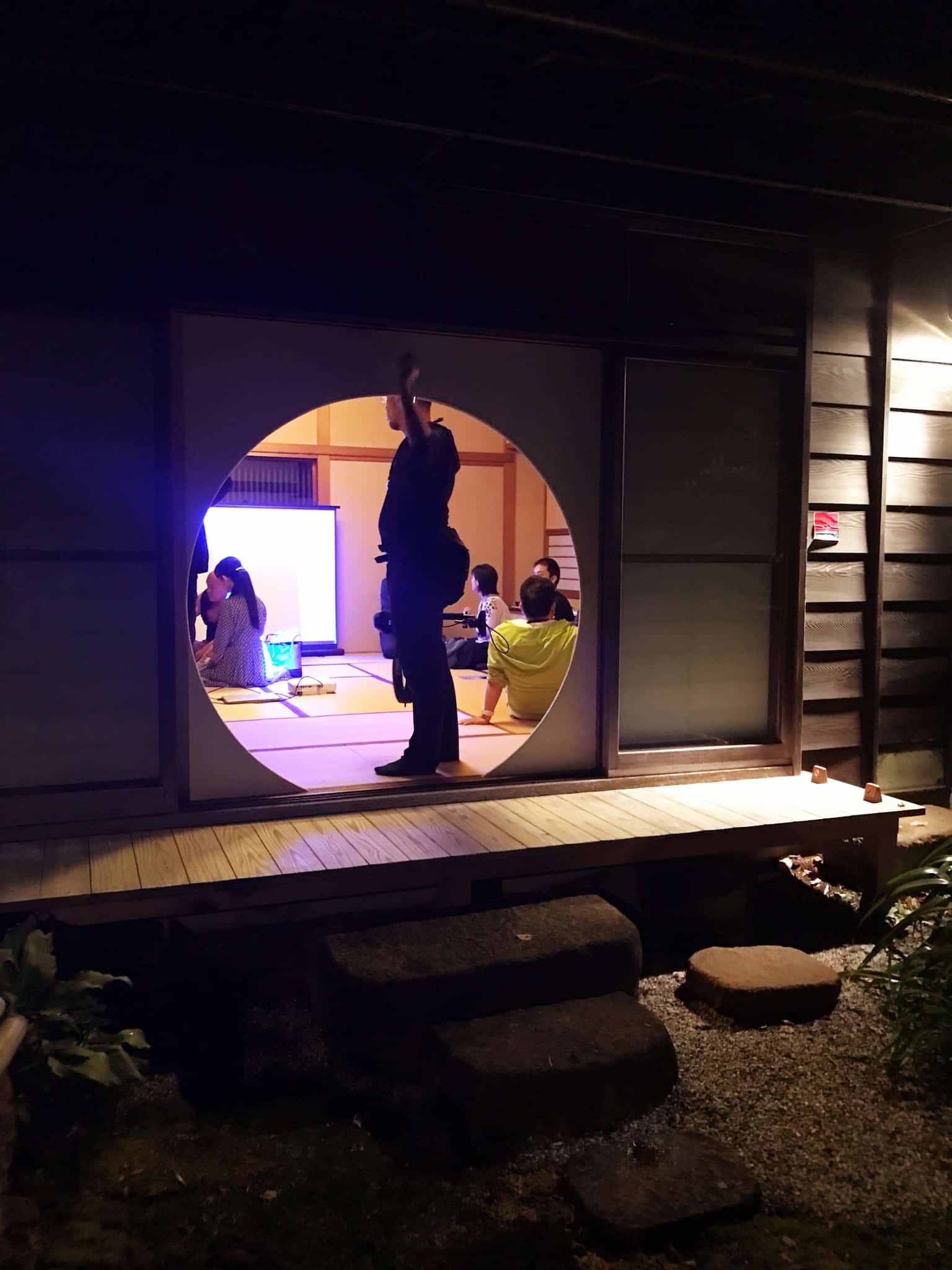
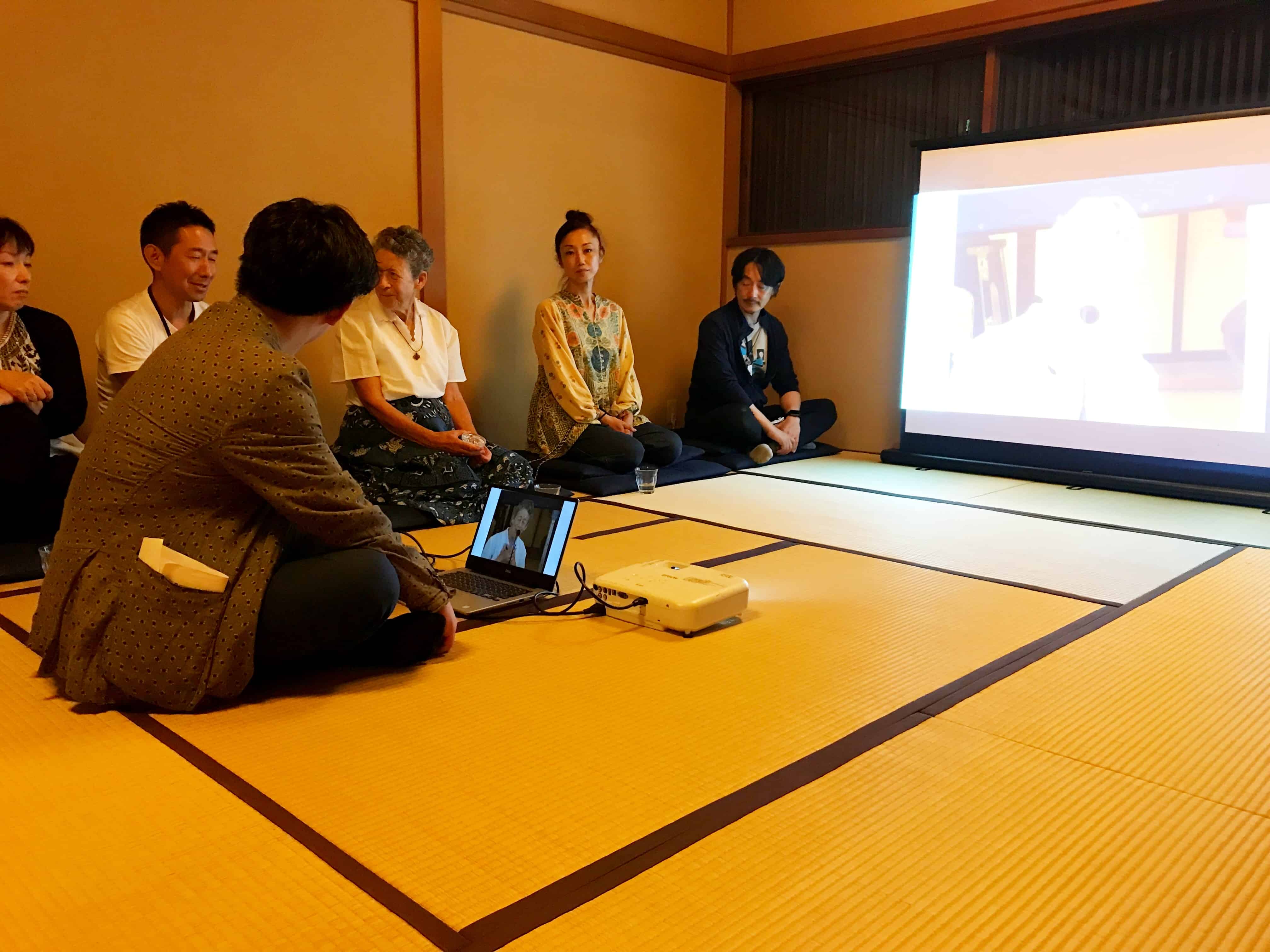
Other great sessions included speakers Rev. Gengo Akiba led a class on “Connection and Circle,” Keerthana Mariappan led a session on “The Mindful Society which Meditation Guides Us To”, Stephen Murphy-Shigematsu and Satoshi Ikeno led a session on “The Light and Shadow of Mindfulness Boom: Thinking into the Future,” whereas Takashi Maeno and Madoka Maeno led a session on “Respect, Growth and Humor.”

We also learned about “Connectedness of the Heart” from Sanae Kishimoto, the “Mindfulness of Cacao and Global Sustainability” from Shingo Isihara and Mikio Shishido, and “Technology in the Reiwa Era and the New Way of the Economy” from Daisuke Yanasawa and Kaname Hayashi. Also on the agenda was “Mindfulness Disseminating Into Our Everyday Life,” with Phra Yuki Naradevo and Ikuko Yamaguchi and “Being with People in Times of Pain” with Masahiro Fujino.
And, Jeffery A. Martin came all the way over from the states to present on “Science and Mindfulness.” In other words, how to bring science into the study of well-being and enlightenment. We love his work at TransTech, a conference we have been going to as a media partner from the very early days. Note that it is held every fall in Silicon Valley— here‘s our coverage from TransTech 2018. There was also an Itoen Ocha tea experience several times throughout the conference: “Tea Triggers People to Stop and Stand Still.”

Check out their English website for more information. The price for a general two day admission pass this year was just under $200 so incredibly reasonable. Consider joining them next year and sit with YOU and all that shows up, for a few days of compassion, kindness, love, mindfulness and connectedness in one of the most spiritual countries in the world.
Here’s a short video of our experience at Zen 2.0 in September.